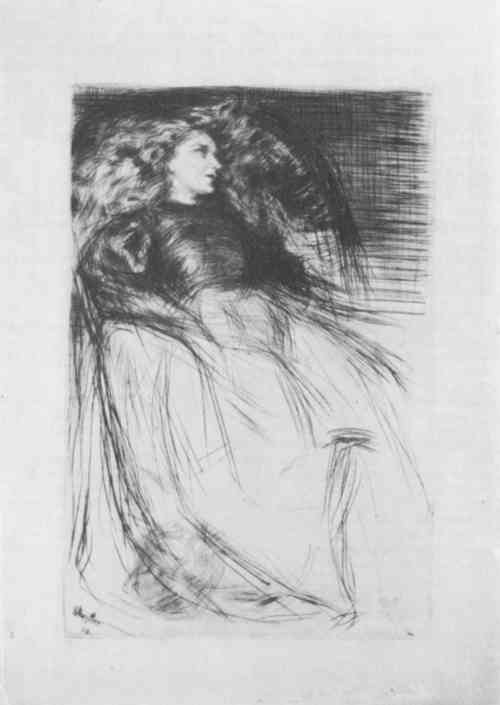THE TREATMENT OF THREE PRINTS BY WHISTLER ON FINE JAPANESE TISSUEShelley Fletcher, & Judith Walsh
3 “Friction Drying” the PrintsROUTINE FLATTENING METHODS were used. The print was rewet, partially air dried, and placed between blotters under felts and a one-half inch plexi-glass plate the same size as the blotters. The blotters were changed after one-half hour. After complete drying, cockles developed in the sheet across the corners but the puckers were gone. The sheet was wetted again, placed between blotters under felts, plexi-glass and light weights. The blotters were changed after five minutes and again after one-half hour. The sheet dried very quickly and developed the same cockles noted above after a few days. Several methods of “friction” drying between sheets of Japanese tissue were suggested.6 The method used was based on those suggestions. A new piece of thin Japanese tissue was used as our test. We cut it to the same size as Weary, wet it, and allowed it to air dry thoroughly. The test sheet developed puckers similar to those on the Whistler print. Rewetting and drying between changes of blotters under felts and under glass, with or without weights, left puckers, creases and draws across the sheet. To dry the practice sheet without distortions we experimented with a Japanese tissue sandwich using different tissues (usugami or gampi) applied cross-grain or parallel-grain to the sample object with varying amounts of moisture and pressure. The packages were dried between blotters under felts with and without weights. Finally, the Whistler print was successfully dried in the following manner: Two usugami tissue supports were cut about four inches larger than the print and their grains marked. One sheet of usugami tissue was floated on Mylar on deionized water. The dry print was centered on the usugami, allowed to wet and relax completely. The Mylar-usugami-print package was lifted from the bath and placed Mylar-side down on clean glass. Another piece of Mylar was put in the tray and the other sheet of usugami was placed on it. This Mylar-supported usugami was then drawn from the tray and placed tissue side down on the Whistler, making a Mylar-usugami-Whistler-usugami-Mylar package, all tissue being placed with their grains parallel. A Japanese smoothing brush was drawn across the Mylar to insure contact of the Japanese tissues and to drain off the excess water. No size or adhesive was used to further adhere the paper. The Mylar sheets were carefully rolled off, the usugami sandwich blotted, then placed between blotters and under felts and weights. After five minutes the blotters were changed and again after fifteen minutes (see Figure 3.).
After one and one-half hours, when the package felt dry, the usugami supports were removed. The usugami sheets were still in good contact with the print and had to be removed very carefully, especially where there were small edge losses in the print. The print was placed between fresh blotters and under felts and weights for several days. When removed, Weary was free of distortion and remains so (see Figure 4.).
The second print, Nude Model (B14,015) from the Lessing J. Rosenwald Collection, was executed on an exceptionally fine Japanese tissue, Koppi-shi, or “copypaper.”7 It was mounted to a paper-faced wood-pulp board with paste exactly as described for Weary. It was removed from the cardboard and treated with enzymes exactly as described for Weary. Drying was attempted as in the previous case: sheets of usugami cut two inches bigger all-around were friction mounted with grains aligned to the wetted Differences in expansion upon wetting of the print and usugami were hypothesized as the cause for this failure in our friction-drying technique. Fiber samples were made from the three prints and the usugami tissue. Interestingly, only two Japanese fibers were found to be present in all these tissues and only one sheet was a combination of fibers: Weary was 50 percent kozo and 50 percent gampi; the usugami: 100 percent kozo, the Nude Models: 100 percent gampi.8 Tissues composed purely of gampi (gampi) and purely of kozo (usugami, kizukishi, sekishu), were cut to uniform sizes and measured both across and along the grain while wet and upon subsequent drying. The kozo samples each expanded exactly twice as much across the grain as along the grain, 2.3 mm maximum over 20.3 cm. The gampi tissue sample showed great expansion, three times as much across the grain as along the grain, 7.9 mm maximum over 20.3 cm.9 We assumed from this data that successful friction drying relies on similar contraction of all the tissues in the package during drying. We successfully dried the 100 percent gampi Whistler lithograph between sheets of gampi tissue using the same system of blotters, felts, glass and weights. The third print, Nude Model, Standing (B14,015) from the Lessing J. Rosenwald Collection, on fine koppi-shi tissue, was badly torn near one corner where the interior of the tissue had begun to separate from its pasted edge. To compound the problem, the tear had been repaired by re-affixing the torn edges to the board. When removed from the board and washed, the print was lined with tengujo tissue (chosen for its fineness, even texture, and lack of grain). This lined sheet was successfully dried between sheets of gampi, reinforcing our belief that similar expansion on wetting and contraction on drying in the cover sheets and the print is absolutely necessary in successful friction-drying. ACKNOWLEDGEMENTSWe would like to thank Nancy Ash, Conservation Intern, New York University, 1977–78, for her valuable assistance in the treatment of these prints. |

